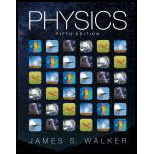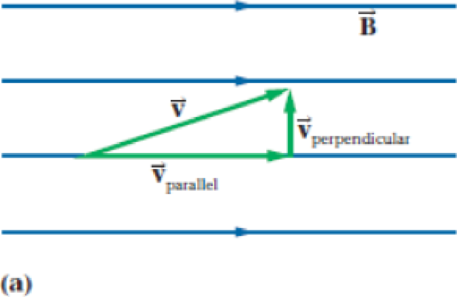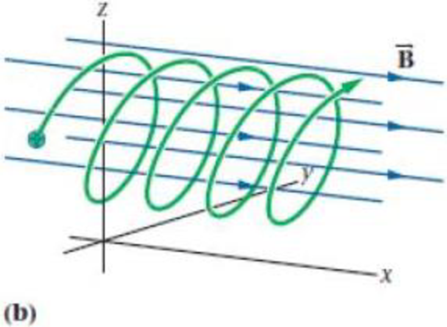1 Introduction To Physics 2 One-Dimensional Kinematics 3 Vectors In Physics 4 Two-Dimensional Kinematics 5 Newton’s Laws Of Motion 6 Applications Of Newton’s Laws 7 Work And Kinetic Energy 8 Potential Energy And Conservation Of Energy 9 Linear Momentum And Collisions 10 Rotational Kinematics And Energy 11 Rotational Dynamics And Static Equilibrium 12 Gravity 13 Oscillations About Equilibrium 14 Waves And Sound 15 Fluids 16 Temperature And Heat 17 Phases And Phase Changes 18 The Laws Of Thermodynamics 19 Electric Charges, Forces, And Fields 20 Electric Potential And Electric Potential Energy 21 Electric Current And Direct-Current Circuits 22 Magnetism 23 Magnetic Flux And Faraday’s Law Of Induction 24 Alternating-Current Circuits 25 Electromagnetic Wave 26 Geometrical Optics 27 Optical Instruments 28 Physical Optics: Interference And Diffraction 29 Relativity 30 Quantum Physics 31 Atomic Physics 32 Nuclear Physics And Nuclear Radiation expand_more
22.1 The Magnetic Field 22.2 The Magnetic Force On Moving Charges 22.3 The Motion Of Charged Particles In A Magnetic Field 22.4 The Magnetic Force Exerted On A Current-Carrying Wire 22.5 Loops Of Current And Magnetic Torque 22.6 Electric Currents, Magnetic Fields, And Ampère’s Law 22.7 Current Loops And Solenoids Chapter Questions expand_more
Problem 1CQ: Two charged particles move at right angles to a magnetic field and deflect in opposite directions.... Problem 2CQ: An electron moves with constant velocity through a region of space that is free of magnetic fields.... Problem 3CQ: An electron moves with constant velocity through a region of space that is free of electric fields.... Problem 4CQ: Describe how the motion of a charged particle can be used to distinguish between an electric and a... Problem 5CQ: Explain how a charged particle moving in a circle of small radius can take the same amount of time... Problem 6CQ: A current-carrying wire is placed in a region with a uniform magnetic field. The wire experiences... Problem 1PCE: Predict/Explain Proton 1 moves with a speed v from the east coast to the west coast in the... Problem 2PCE: An electron moving in the positive x direction, at right angles to a magnetic field, experiences a... Problem 3PCE: Suppose particles A, B, and C in Figure 22-41 have identical masses and charges of the same... Problem 4PCE: Referring to Figure 22-41, what is the sign of the charge for each of the three particles? Explain.... Problem 5PCE: What is the acceleration of a proton moving with a speed of 7.5 m/s at right angles to a magnetic... Problem 6PCE: An electron moves at right angles to a magnetic field of 0.23 T. What is its speed if the force... Problem 7PCE: A negatively charged ion moves due north with a speed of 1.5 106 m/s at the Earths equator. What is... Problem 8PCE Problem 9PCE: A 0.32-C particle moves with a speed of 16 m/s through a region where the magnetic field has a... Problem 10PCE: A particle with a charge of 18C experiences a force of 2.8 104 N when it moves at right angles to a... Problem 11PCE: An ion experiences a magnetic force of 6.2 1016 N when moving in the positive x direction but no... Problem 12PCE: An electron moving with a speed of 4.0 105 m/s in the positive x direction experiences zero... Problem 13PCE: Predict/Calculate Two charged particles with different speeds move one at a time through a region of... Problem 14PCE: A 6.60-C particle moves through a region of space where an electric field of magnitude 1450 N/C... Problem 15PCE Problem 16PCE: A velocity selector is to be constructed using a magnetic field in the positive y direction. If... Problem 17PCE: Charged particles pass through a velocity selector with electric and magnetic fields at right angles... Problem 18PCE Problem 19PCE: Find the radius of the orbit when (a) an electron or (b) a proton moves perpendicular to a magnetic... Problem 20PCE: BIO Predict/Calculate The artery in Figure 22-14 has an inside diameter of 2.75 mm and passes... Problem 21PCE: An electron accelerated from rest through a voltage of 750 V enters a region of constant magnetic... Problem 22PCE: A 10.2-C particle with a mass of 2.80 105 kg moves perpendicular to a 0.850-T magnetic field in a... Problem 23PCE: Predict/Calculate When a charged particle enters a region of uniform magnetic field, it follows a... Problem 24PCE: A proton with a kinetic energy of 4.6 1016 J moves perpendicular to a magnetic field of 0.36 T.... Problem 25PCE: Predict/Calculate An alpha particle (the nucleus of a helium atom) consists of two protons and two... Problem 26PCE Problem 27PCE: Helical Motion As a model of the physics of the aurora, consider a proton emitted by the Sun that... Problem 28PCE: What is the magnetic force exerted on a 2.35-m length of wire carrying a current of 0.819 A... Problem 29PCE: A wire with a current of 2.1 A is at an angle of 38.0 relative to a magnetic field of 0.78 T. Find... Problem 30PCE: The magnetic force exerted on a 1.2-m segment of straight wire is 1.6 N. The wire carries a current... Problem 31PCE: A 0.61 -m copper rod with a mass of 0.043 kg carries a current of 15 A in the positive x direction.... Problem 32PCE: The long, thin wire shown in Figure 22-45 is in a region of constant magnetic field B. The wire... Problem 33PCE: A wire with a length of 3.8 m and a mass of 0.65 kg is in a region of space with a magnetic field of... Problem 34PCE: Loudspeaker Force The coil in a loudspeaker has 50 turns and a radius of 3.8 cm. The magnetic field... Problem 35PCE: A high-voltage power line carries a current of 110 A at a location where the Earths magnetic field... Problem 36PCE Problem 37PCE: For each of the three situations shown in Figure 22-47, indicate whether there will be a tendency... Problem 38PCE: A rectangular loop of 280 turns is 35 cm wide and 19 cm high. What is the current in this loop if... Problem 39PCE: A single circular loop of radius 0.15 m carries a current of 3.1 A in a magnetic field of 0.91 T.... Problem 40PCE: In the previous problem, find the angle the plane of the loop must make with the field if the torque... Problem 41PCE: A square loop of wire 0.15 m on a side lies on a horizontal table and carries a counterclockwise... Problem 42PCE: Predict/Calculate Each of the 10 turns of wire in a vertical, rectangular loop carries a current of... Problem 43PCE Problem 44PCE: How much current must pass through a horizontal power transmission cable in order for the magnetic... Problem 45PCE: You travel to the north magnetic pole of the Earth, where the magnetic field points vertically... Problem 46PCE: BIO Pacemaker Switches Some pacemakers employ magnetic reed switches to enable doctors to change... Problem 47PCE: Two power lines, each 290 m in length, run parallel to each other with a separation of 23 cm. If the... Problem 48PCE: Predict/Calculate Consider the long, straight, current-carrying wires shown in Figure 22. One wire... Problem 49PCE: In Oersteds experiment, suppose that the compass was 0.15 m from the current-carrying wire. If a... Problem 50PCE Problem 51PCE Problem 52PCE: A loop of wire is connected to the terminals of a battery, as indicated in Figure 22-51. If the loop... Problem 53PCE: Predict/Explain The number of turns in a solenoid is doubled, and at the same time its length is... Problem 54PCE: A circular coil of wire has a radius of 7.5 cm and has 125 turns of wire that carries 6.6 A of... Problem 55PCE: The solenoid for an automobile power door lock is 2.5 cm long and has 190 turns of wire that carry... Problem 56PCE: It is desired that a solenoid 25 cm long and with 350 turns produce a magnetic field within it equal... Problem 57PCE: A solenoid that is 72 cm long produces a magnetic field of 1.8 T within its core when it carries a... Problem 58PCE: The maximum current in a superconducting solenoid can be as large as 3.75 kA. If the number of turns... Problem 59PCE: To construct a solenoid, you wrap insulated wire uniformly around a plastic tube 7.6 cm in diameter... Problem 60GP: CE A proton is to orbit the Earth at the equator using the Earths magnetic field to supply part of... Problem 61GP: CE Figure 22-52 shows an electron beam whose initial direction of motion is horizontal, from right... Problem 62GP: CE The three wires shown in Figure 22-53 are long and straight, and they each carry a current of the... Problem 63GP: CE Each of the current-carrying wires in Figure 22-53 is long and straight, and carries the current... Problem 64GP: CE The four wires shown in Figure 22-54 are long and straight, and they each carry a current of the... Problem 65GP: CE Each of the current-carrying wires in Figure 22-54 is long and straight, and carries the current... Problem 66GP: BIO Brain Function and Magnetic Fields Experiments have shown that thought processes in the brain... Problem 67GP: Credit-Card Magnetic Strips Experiments carried out on the television show Mythbusters determined... Problem 68GP Problem 69GP Problem 70GP: CE A positively charged particle moves through a region with a uniform electric field pointing... Problem 71GP: CE A proton follows the path shown in Figure 22-56 as it moves through three regions with different... Problem 72GP: CE Predict/Explain Suppose the initial speed of the proton in Figure 22-56 is increased. (a) Does... Problem 73GP: BIO Magnetic Resonance Imaging An MRI (magnetic resonance imaging) solenoid produces a magnetic... Problem 74GP: Predict/Calculate A long, straight wire carries a current of 14 A. Next to the wire is a square loop... Problem 75GP: A particle with a charge of C moves with a speed of 77 m/s in the positive x direction. The magnetic... Problem 76GP: Predict/Calculate A beam of protons with various speeds is directed in the positive x direction. The... Problem 77GP Problem 78GP: Repeat Problem 77 for the case where the current in wire 1 is reversed in direction. Problem 79GP: Electric Motor A current of 2.4 A flows through a circular coil of wire with 52 turns and a radius... Problem 80GP Problem 81GP: Lightning Bolts A powerful bolt of lightning can carry a current of 225 kA. (a) Treating a lightning... Problem 82GP: Predict/Calculate Consider the two current-carrying wires shown in Figure 22-61. The current in wire... Problem 83GP: Magnetars The astronomical object 4U014 + 61 has the distinction of creating the most powerful... Problem 84GP Problem 85GP: Solenoids produce magnetic fields that are relatively intense for the amount of current they carry.... Problem 86GP: The current in a solenoid with 28 turns per centimeter is 0.55 A. The solenoid has a radius of 1.5... Problem 87GP Problem 88GP: Synchrotron Undulator In one portion of a synchrotron undulator, electrons traveling at 2.99 108... Problem 89GP: Predict/Calculate A single current-carrying circular loop of radius R is placed next to a long,... Problem 90GP Problem 91GP: A solenoid is made from a 25-m length of wire of resistivity 2.3 108 m. The wire, whose radius is... Problem 92GP: Magnetic Fields in the Bohr Model In the Bohr model of the hydrogen atom, the electron moves in a... Problem 93GP: A single-turn square loop carries a current of 18 A. The loop is 15 cm on a side and has a mass of... Problem 94GP: Approximating a neuron by a straight wire, what electric current is needed to produce a magnetic... Problem 95PP: Suppose a neuron in the brain carries a current of 5.0 108 A. Treating the neuron as a straight... Problem 96PP: A given neuron in the brain carries a current of 3.1 108 A. If the SQUID detects a magnetic field... Problem 97PP: A SQUID detects a magnetic field of 1.8 1014 T at a distance of 13 cm. How many electrons flow... Problem 98PP: Predict/Calculate Referring to Example 22-7 Suppose the speed of the isotopes is doubled (a) Does... Problem 99PP: Predict/Calculate Referring to Example 22-7 Suppose we change the initial speed of 238U, leaving... Problem 100PP: Referring to Quick Example 22-15 The current I1 is adjusted until the magnetic field halfway between... Problem 101PP: Referring to Quick Example 22-15 The current I2 is adjusted until the magnetic field 5.5 cm below... format_list_bulleted





 Principles of Physics: A Calculus-Based TextPhysicsISBN:9781133104261Author:Raymond A. Serway, John W. JewettPublisher:Cengage Learning
Principles of Physics: A Calculus-Based TextPhysicsISBN:9781133104261Author:Raymond A. Serway, John W. JewettPublisher:Cengage Learning College PhysicsPhysicsISBN:9781938168000Author:Paul Peter Urone, Roger HinrichsPublisher:OpenStax College
College PhysicsPhysicsISBN:9781938168000Author:Paul Peter Urone, Roger HinrichsPublisher:OpenStax College Physics for Scientists and Engineers: Foundations...PhysicsISBN:9781133939146Author:Katz, Debora M.Publisher:Cengage Learning
Physics for Scientists and Engineers: Foundations...PhysicsISBN:9781133939146Author:Katz, Debora M.Publisher:Cengage Learning Glencoe Physics: Principles and Problems, Student...PhysicsISBN:9780078807213Author:Paul W. ZitzewitzPublisher:Glencoe/McGraw-Hill
Glencoe Physics: Principles and Problems, Student...PhysicsISBN:9780078807213Author:Paul W. ZitzewitzPublisher:Glencoe/McGraw-Hill Physics for Scientists and Engineers, Technology ...PhysicsISBN:9781305116399Author:Raymond A. Serway, John W. JewettPublisher:Cengage Learning
Physics for Scientists and Engineers, Technology ...PhysicsISBN:9781305116399Author:Raymond A. Serway, John W. JewettPublisher:Cengage Learning




